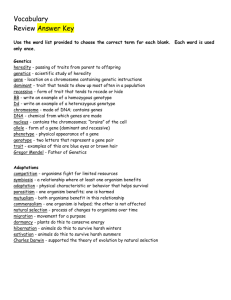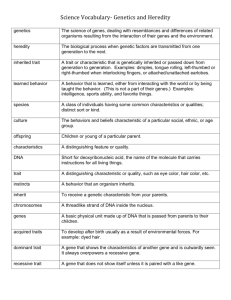Cells and Traits Vocabulary
advertisement
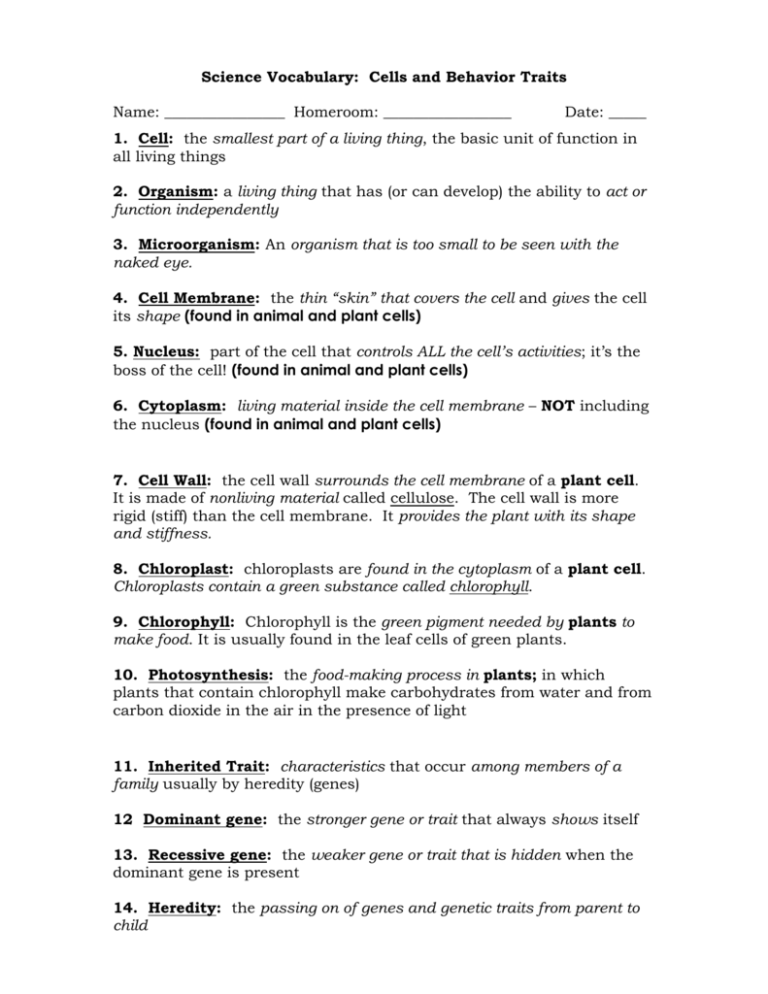
Science Vocabulary: Cells and Behavior Traits Name: ________________ Homeroom: _________________ Date: _____ 1. Cell: the smallest part of a living thing, the basic unit of function in all living things 2. Organism: a living thing that has (or can develop) the ability to act or function independently 3. Microorganism: An organism that is too small to be seen with the naked eye. 4. Cell Membrane: the thin “skin” that covers the cell and gives the cell its shape (found in animal and plant cells) 5. Nucleus: part of the cell that controls ALL the cell’s activities; it’s the boss of the cell! (found in animal and plant cells) 6. Cytoplasm: living material inside the cell membrane – NOT including the nucleus (found in animal and plant cells) 7. Cell Wall: the cell wall surrounds the cell membrane of a plant cell. It is made of nonliving material called cellulose. The cell wall is more rigid (stiff) than the cell membrane. It provides the plant with its shape and stiffness. 8. Chloroplast: chloroplasts are found in the cytoplasm of a plant cell. Chloroplasts contain a green substance called chlorophyll. 9. Chlorophyll: Chlorophyll is the green pigment needed by plants to make food. It is usually found in the leaf cells of green plants. 10. Photosynthesis: the food-making process in plants; in which plants that contain chlorophyll make carbohydrates from water and from carbon dioxide in the air in the presence of light 11. Inherited Trait: characteristics that occur among members of a family usually by heredity (genes) 12 Dominant gene: the stronger gene or trait that always shows itself 13. Recessive gene: the weaker gene or trait that is hidden when the dominant gene is present 14. Heredity: the passing on of genes and genetic traits from parent to child Science Study Guide: Cells and Behavior Traits Name: ________________ Homeroom: _________________ Date: _____ 1. What is the purpose or function of a cell? 2. What are the parts of a plant cell? What are the parts of an animal cell? Plant Cell Animal Cell 3. What is the difference between a multi-celled organism and a single-celled organism? Multi-celled organism – Single-celled organism – 4. What are genes? 5. What is a dominant trait? What is a recessive trait? Dominant Trait – Recessive Trait - 6. What are some traits that we inherit? 5th Grade Study Guide: Cells 1. What is the purpose or function of a cell? The cell is the basic structure of all living things. It carries on ALL of life’s processes. 2. What are the parts of a plant cell? What are the parts of an animal cell? Plant Cell Nucleus Vacuole Cell Membrane Cytoplasm Mitochondria Animal Cell Nucleus Vacuole Cell Membrane Cytoplasm Mitochondria ***Cell Wall ***Chloroplast 3. What is the difference between a multi-celled organism and a single-celled organism? Multi-celled organism – an organism with similar cells, it has more than one cell. These cells work together Animals, plants, and fungus are all multi-celled organisms Single-celled organism – organisms that are made up of one cell, some, like bacteria, do not even have a nucleus Bacteria and protist are single-celled 4. What are genes? A gene is a small part of a chromosome that determines the traits of an organism. Chromosomes are rod shaped and found in pairs. Chromosomes DNA 5. What is a dominant trait? What is a recessive trait? Dominant Trait – the stronger gene or trait that always shows itself…Examples include: brown eyes, dark hair, curly hair, dimples, freckles, unattached earlobes Recessive Trait – the weaker gene that is hidden when the dominant trait is present...Examples include: green/hazel/blue eyes, blonde/red/light color hair, no dimples, no freckles, attached earlobes 6. What are some traits that we inherit? Eye color, hair color, eyelash length, earlobe shape, skin color, right or left handed, height, rolled tongue, gap in teeth, widows peak Science Vocabulary Test: Cells and Behavior Traits Directions: Choose the correct vocabulary word from the box below. Write the correct word on the line provided. Inherited Trait Dominant Gene Recessive Gene Heredity 1. The ________________ is the stronger gene or trait that always shows itself 2. ________________ is the passing on of genes and genetic traits from parent to child 3. ________________ characteristics that occur among members of a family usually by heredity (genes) 4. ________________ the weaker gene or trait that is hidden when the dominant gene is present Cell Nucleus Cell Membrane Organism Cytoplasm Microorganism 5. The _______________ is the thin “skin” that covers the cell and gives the cell its shape (animal and plant cells) 6. The _________________ is living material inside the cell membrane – not including the nucleus (animal and plant cells) 7. A ________________ is the smallest part of a living thing, the basic unit of function in all living things 8. The ________________ is part of the cell that controls ALL the cell’s activities; it’s the boss of the cell (animal and plant cells) 9. An ________________ is a living thing that has the ability to act or function independently 10. A _______________ is an organism that is too small to be seen with the naked eye Photosynthesis Cell Wall Chloroplast Chlorophyll 11. ______________ is the green pigment needed by plants to make food; usually found in the leaf cells of green plants 12. The ______________ surrounds the cell membrane of a plant cell; it is made of nonliving material called cellulose; provides the plant with its shape and stiffness 13. ______________ is the food-making process in plants 14. ______________ found in the cytoplasm of a plant cell; contains a green substance called chlorophyll Science Test: Cells, Behavior Traits, the 6 Kingdoms Directions: Read each question carefully. Circle the correct answer. 1. In which kingdom can single-cell organisms be found? A. Animal kingdom B. Plant kingdom C. Bacteria kingdom 2. Which two features will identify a cell as a plant cell and not an animal cell? A. chloroplast and cell wall B. cell membrane and mitochondria C. cell wall and nucleus 3. In both an animal and a plant cell, which gel-like structure holds the organelles inside the cell? A. vacuole B. cytoplasm C. cell membrane 4. List below the two main groups that the animal kingdom and the plant kingdom can be divided into: Animal Plant 1. 1. 2. 2. 5. Which structure of an animal and a plant cell is the control center, or the boss? A. Endoplasmic Reticulum B. Mitochondria C. Nucleus 6. What is the difference between a multi-celled and a single-celled organism? ____________________________________________________________ ____________________________________________________________ 7. The stronger gene or trait that always shows itself is the…. A. recessive gene B. nucleus gene C. dominant gene ***Please give a few examples: D. heredity 8. The weaker gene or trait that is sometimes hidden is the…. A. recessive gene B. nucleus gene C. dominant gene D. heredity *** Please give a few examples: 9. List at least 3 traits that we can inherit from our family? 10. What organelles of a cell are found in BOTH an animal and a plant cell? (name at least 3) Bonus: 1. If you could choose to be any organelle in a plant or animal cell, which would you choose and why? 2. What type of plant can make fruit and flowers from the seeds? 3. What type of plant can make seeds but not fruit or flowers? 4. Below list the animal vertebrates that are cold-blooded and those that are warm-blooded: Cold-blooded 1. 2. 3. Warm-blooded 1. 2. DOMINANT AND RECESSIVE CHARACTERISTICS Characteristics in the left-hand column dominate over those characteristics listed in the right-hand column. DOMINANT TRAITS RECESSIVE TRAITS eye coloring brown eyes grey, green, hazel, blue eyes vision farsightedness normal vision normal vision normal vision normal vision nearsightedness night blindness color blindness* hair dark hair non-red hair curly hair full head of hair widow's peak blonde, light, red hair red hair straight hair baldness* normal hairline facial features dimples unattached earlobes freckles broad lips no dimples attached earlobes no freckles thin lips appendages extra digits fused digits short digits fingers lack 1 joint limb dwarfing clubbed thumb double-jointedness normal number normal digits normal digits normal joints normal proportion normal thumb normal joints other immunity to poison ivy normal pigmented skin normal blood clotting normal hearing normal hearing and speaking normal- no PKU susceptibility to poison ivy albinism hemophilia* congenital deafness deaf mutism phenylketonuria (PKU)


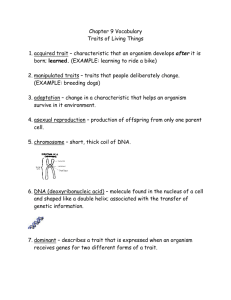
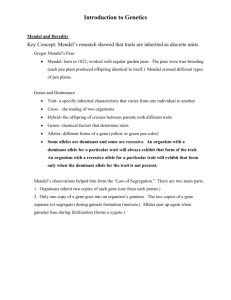

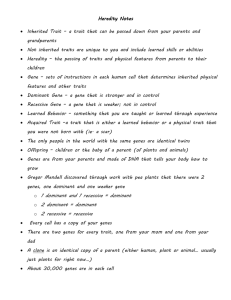
![Biology Chapter 3 Study Guide Heredity [12/10/2015]](http://s3.studylib.net/store/data/006638861_1-0d9e410b8030ad1b7ef4ddd4e479e8f1-300x300.png)
